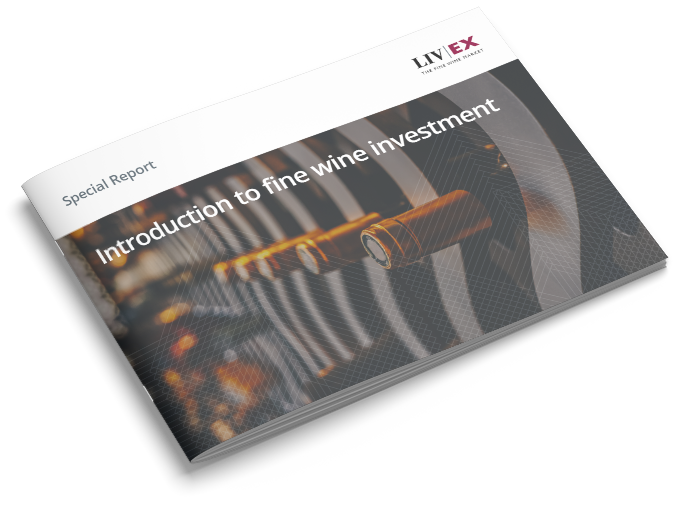Print and read offline instead.
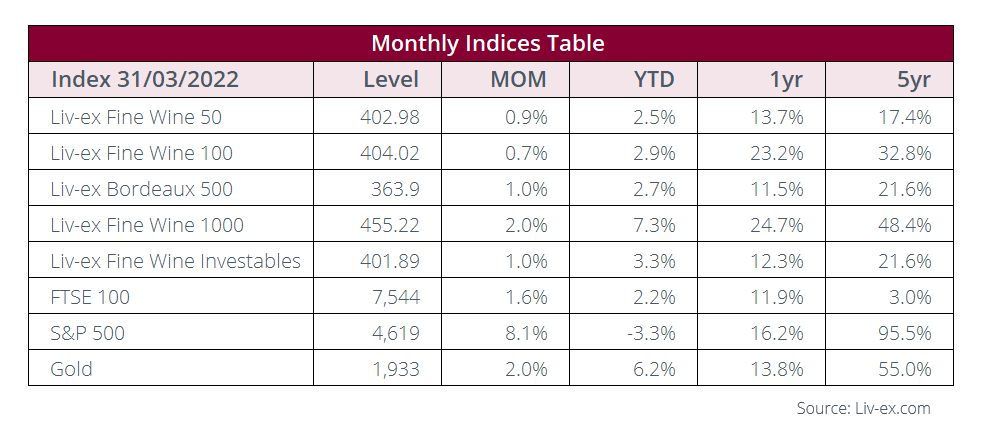
New La Place releases amid increased market activity in March
Fine wine enjoyed an uptick in activity in March, with trade value up 21.5% on the previous month and the number of wines trading up 19.6%. Prices rose more than in February, with the Liv-ex 100 index up 0.7% and the Liv-ex 1000 up 2.0%.
The best-performing wines within the Liv-ex 100 were a mix from the Rhône, Champagne, California and Barolo. The Liv-ex 1000’s gains were led by the Burgundy 150 (4.0%) and the Champagne 50 (2.6%) sub-indices.
In March, Bordeaux improved its share of trade to 36.2% of the market by value. The increase was driven by its 2019 and 2018 vintages. Meanwhile, Burgundy dipped from 26.3% of the market in February to 24.9%, and Champagne from 12.8% to 11.2%.
Nonetheless, wines from Champagne topped March’s most traded. Louis Roederer Cristal 2014 was the most traded wine by value, and Billecart-Salmon Brut Rosé by volume.
Australia (1.1%) and Chile (0.9%) led trade among the ‘others’ category (5.0%). Chilean fine wine was in the spotlight after library stock of Seña 2009 was offered through La Place de Bordeaux.
Other notable releases in March included the 2019 vintage from Château d’Yquem, Château Latour 2014 and Ao Yun 2018.
Risers from the Rhône and Burgundy

Although the Rhône 100 index was the fourth-best performing Liv-ex 1000 sub-index in March, a wine from the northern Rhône appellation of Hermitage was one of the top price performers in the Liv-ex 100 index last month – Domaine Jean Louis Chave 2017 was up 15.6%. Another wine from Hermitage Paul Jaboulet Aîné La Chapelle 2018 managed a 7.4% rise. Gains also extended to the southern Rhône’s Châteauneuf-du-Pape as Clos des Papes 2019 went up 3.9%.
The top-performing wines from Burgundy last month were Trapet Père et Fils Chambertin Grand Cru 2018 (7.3%) and Domaine Faiveley Clos des Cortons Faiveley Grand Cru 2019 (6.6%).
Market sentiment towards Burgundy in the past year
Burgundy is, in the round, the most expensive and best-performing fine wine region on the secondary market. As such, it rarely misses the investment spotlight. Yet market sentiment towards the region is somewhat seasonal. In recent years, Burgundy has recorded stronger performaces over the winter months (before and during Burgundy En Primeur), with signs of retreat over spring and early summer (during Bordeaux En Primeur).
Burgundy’s exposure – the total value of bids and offers – hit an all-time high of £24 million in January this year, during the region’s 2020 En Primeur campaign. The bid:offer ratio stood at 1.14 at the time, indicating increased market interest refleacted in rising prices. Generally, a bid:offer ratio of 0.5 and above acts as a measure of positive sentiment in the market.
Last month as overall activity fell, the bid:offer ratio declined to 0.84. The level is still above that in March 2021 (0.54), suggesting that while the appetite for (or interest in) Burgundy has waned as the Bordeaux En Primeur campaign draws closer, overall sentiment remains quietly confident.
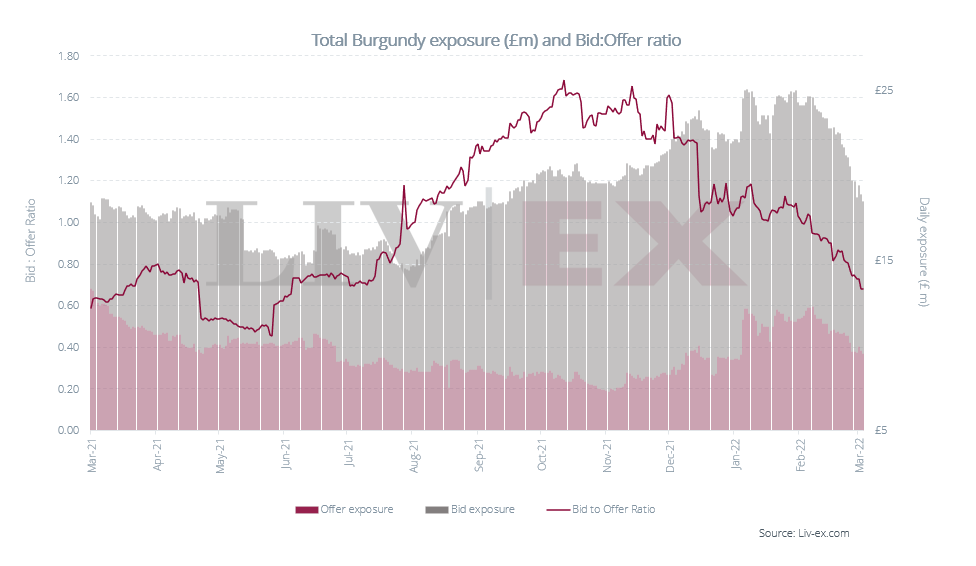
Jancis Robinson finds greater success in 2012 Left Bank Bordeaux 10 years on
Jancis Robinson MW recently reviewed the Bordeaux 2012 vintage 10 years on. Robinson tasted the wines at two events, blind and non-blind. This resulted in some slight variation in scores, as seen in the table below where two ratings are given. Latour and Lafite Rothschild were scored 18 points when tasted blind, but Petrus and Mouton Rothschild got higher marks at the non-blind tasting.
Robinson noted that while 2012 was initially considered a Right Bank vintage, due to Robert Parker’s original commentary, Robinson said that the ‘conclusion in 2022 was that the Left Bank probably produced more wines that could be deemed a success’.
Robinson was also ‘struck by the lack of correlation between price and quality’ and agreed with the conclusions of Farr Vintners’ Stephen Browett that ‘this tasting re-confirmed our expectations that 2012 is a ‘nice’ vintage of ready-to-drink wines but they lack the depth of a great year’.
Her top-scoring wines, along with their current Market Prices, can be seen in the table below. Canon and La Mission Haut-Brion stand out with the only unquestioned 18-point scores. Robinson said of Canon that it was ‘a really complex wine (and there aren’t many 2012s you could think this of)’. The wine has risen 69.5% in value since release. Meanwhile, she described the 2012 La Mission Haut-Brion, which is up 16.1% since release, as ‘long and really rather glorious’.

Industry news
Aubert de Villaine steps down from DRC
After almost half-a-century, Aubert de Villaine has stepped down as co-manager of Domaine de la Romanée-Conti. The 82-year-old winemaker had been at the iconic Burgundy domaine since 1965 and had co-managed the estate since 1974. According to news agency AFP, Villaine will remain on the domaine’s supervisory board.
New owner for Château Loudenne
Château Loudenne, which went into liquidation in November last year, has found a new buyer, Christophe Gouache, owner of the Médoc wineries Château Bellerive and Château Valeyrac. The purchase is part of Gouache’s plans to support organic and sustainable viticulture in the area.
Loudenne was previously owned by China’s most valuable publicly listed company, Kweichow Moutai, whose own ambitions included the establishment of a luxury hotel within the grounds and €5 million investment into modernising the production facilities. Chinese state restrictions on foreign investment put these plans on hold and Kweichow Moutai withdrew its funding, leading to the sale.
Heidi Peterson Barrett leaves Napa Valley’s Kenzo Estate
Heidi Peterson Barrett, the first winemaker of Screaming Eagle, has ended her 20-year career at Kenzo Estate over a disagreement about the release of the 2020 reds. Barrett was not involved in their production as the harvest was interrupted by the Glass Fire, which broke out on 27th September and led to significant smoke over the valley. Kenzo reportedly chose to go ahead with releasing wine from the vintage, which many leading wineries chose not to do because of fears of smoke taint.
VDP producers adopting NFTs
VDP producers adopted a combination of an electronic NFC (Near Field Communication) chip and tag and an NFT (Non-Fungible Token) created by a German start-up VINiD for some of their bottles at the annual VDP Rheingau auction. The ‘Auction Reserves’ will not be released to retailers and are said to be particularly sought-after by collectors. Wine Business International reported that the VDP sees the VINiD as offering an ‘innovative guarantee of authenticity’.
Which have been the most profitable Bordeaux vintages for the supply chain?
Investing in Bordeaux En Primeur is a recurring topic of discussion prior to each campaign. Factors such as the quality of the new vintage, allocations and current market conditions are on the minds of the trade when considering whether and what to buy. The key determinant, however, is price.
Sentiment around the ‘futures market’ has been waning for much of the last decade, particularly when wines released at high prices have declined in value after becoming physical. For instance, the average price of the 2010 vintage, offered at record levels during the China-led bull run in 2011, had declined 11% by the time the vintage became physically available two years later. This is just one of the examples where the inherent promise of future returns has not been immediately fulfilled.
According to a 2020 Liv-ex survey, merchant opinion was divided over the significance of En Primeur. Of the respondents, 38% disagreed that it is the most important buying event of the year; another 17% were neutral. As last year’s opening report pointed out, wine has been slower to sell, with rising stock days among négociants and UK merchants.
But buying wine for investment is a long-term game and En Primeur continues to attract global interest. Today, the total margin since release (the average increase from the château release through to the price today) of some Bordeaux vintages exceeds 200%. Here we examine which have been the most profitable vintages for the supply chain from today’s perspective.
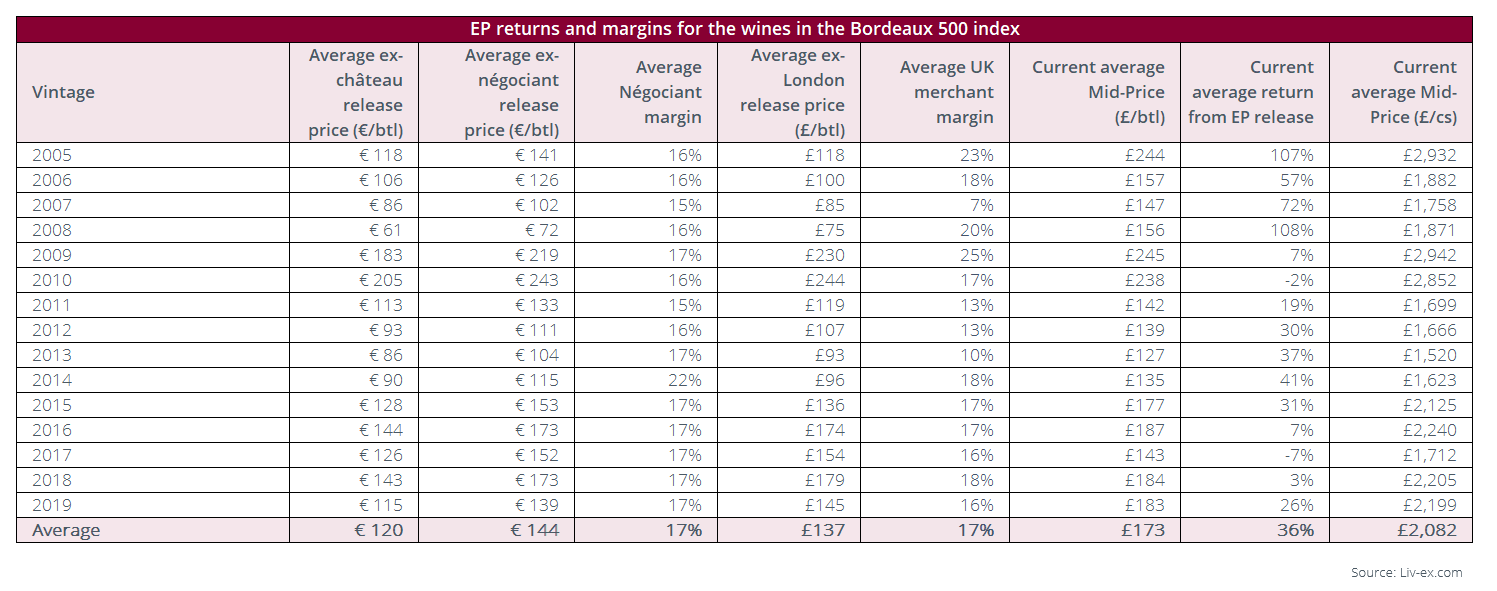
To calculate the average margins, Liv-ex first calculated the average ex-château, ex-négociant, ex-London and current Mid-Prices of the wines in the Bordeaux 500 index and split them by vintage. The margin was estimated based on the difference between the price at each point of delivery.
For the négociants
In the En Primeur system, négociants buy directly from the châteaux, and are the first to apply a margin. Négociants have consistent margins on most vintages (17% on average), with 2014 providing a slight increase (22%).
The 2008 has been the lowest priced vintage since 2005, with an average ex-château price of €61 per bottle for the wines in the Bordeaux 500 index. The 2014 was also among the more affordable offerings at €90 per bottle.
The 2019, viewed as an ‘on’ vintage by critics and trade, was released higher – at €115 per bottle on average. However, this represented a discount on the previous year, and the campaign, launched amid the first wave of the Covid-19 pandemic, revived the buying appetite for En Primeur.
For UK merchants
UK merchants, who buy from the Bordeaux négociants and then sell on to their customers, have applied the highest margins on the 2005 (23%), 2008 (20%) and 2009 (25%) vintages.
For instance, the average price of the 2005 ex-négociant releases was €141 per bottle – around £96 per bottle at the time. UK merchants then offered the wine at £118 per bottle on average.
Total margin
The total margin measures the total increase, from the château release to the average price of the vintage today. It includes the margins of the different supply chain players, like the négociants and merchants who have since traded the wines, and collectors.
As the table above shows, the 2008 vintage has attracted the greatest margin for collectors, 108%, just ahead of the 2005 vintage (107%). The lowest priced vintage on release, it is still among the most affordable Bordeaux. The lowest margin (-7%) has been for the 2017, an ‘off’ vintage released at a high price after the very expensive 2016s.
The 2019 is a recent success story, with an average gain of 26% for buyers in a short space of time. The châteaux price positioning left room for profit for the supply chain and stimulated demand for Bordeaux. In March this year, 2019 was the most traded Bordeaux vintage by value and the second-most by volume.
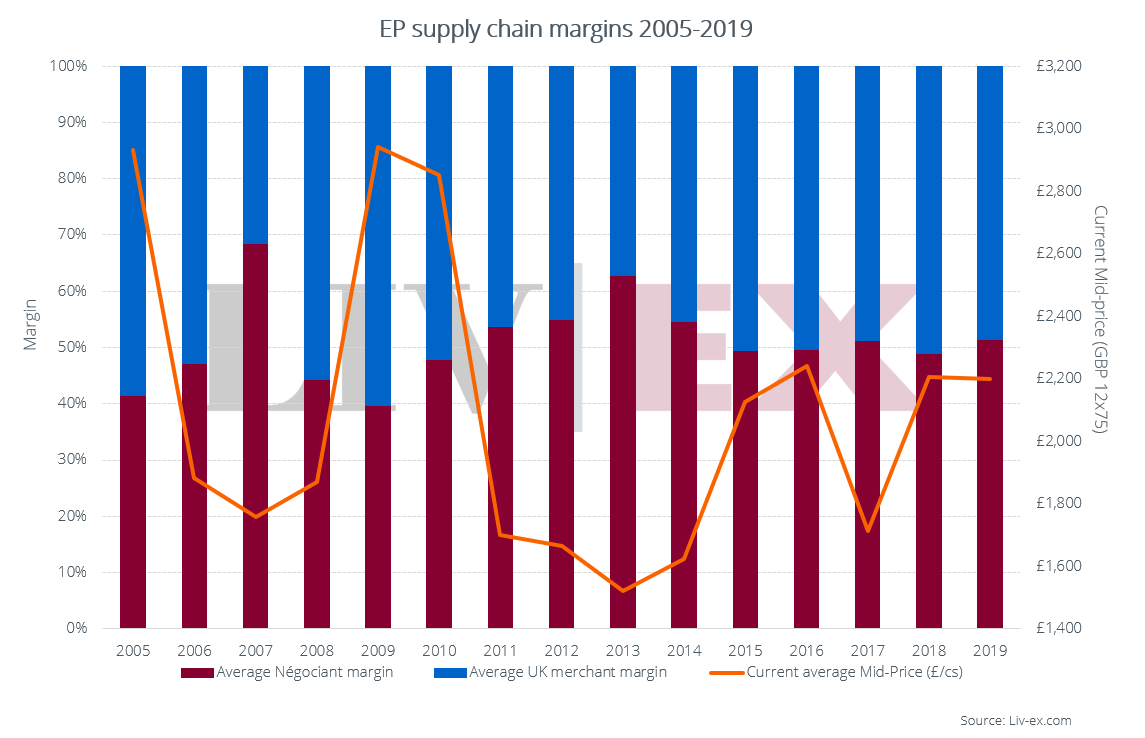
Liv-ex analysis is drawn from the world’s most comprehensive database of fine wine prices. The data reflects the real time activity of Liv-ex’s 560+ merchant members from across the globe. Together they represent the largest pool of liquidity in the world – currently £100m of bids and offers across 16,000 wines. Independent data, direct from the market.



